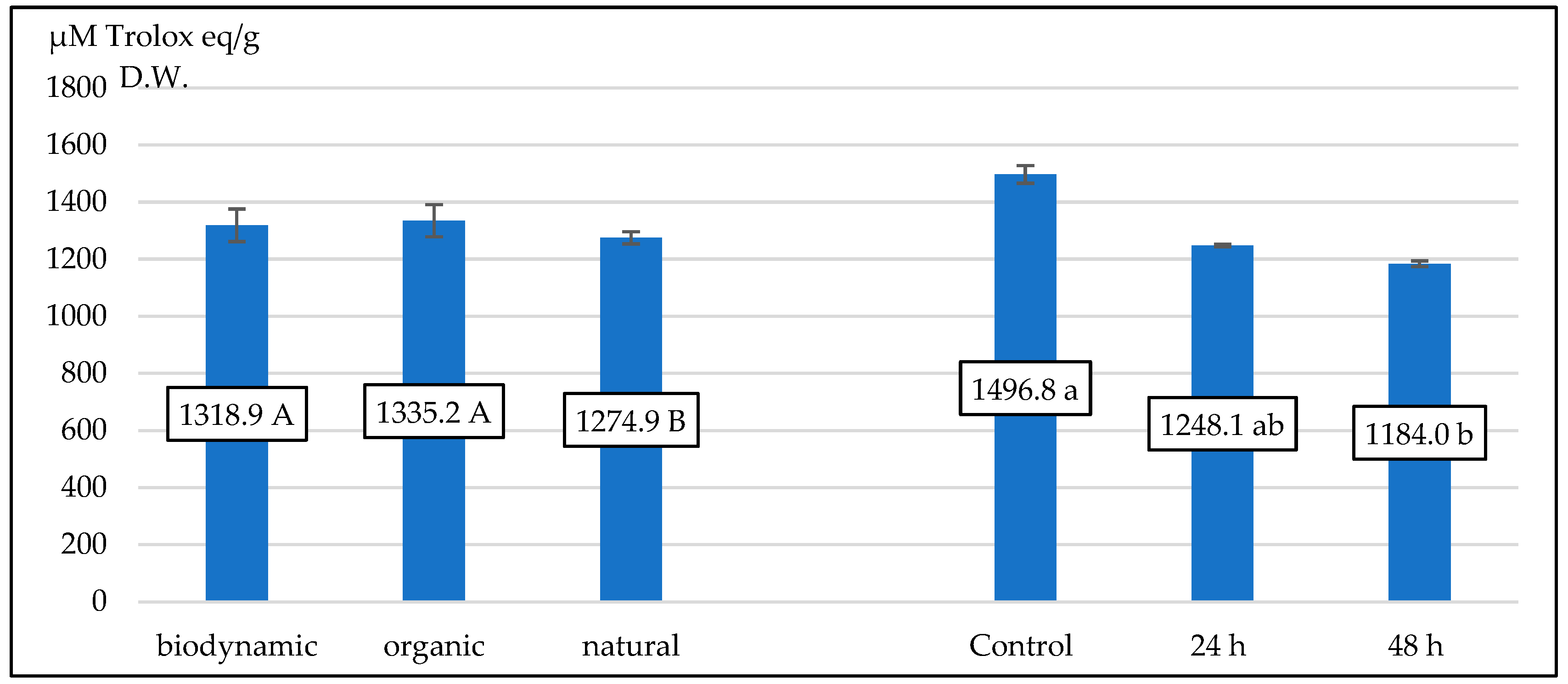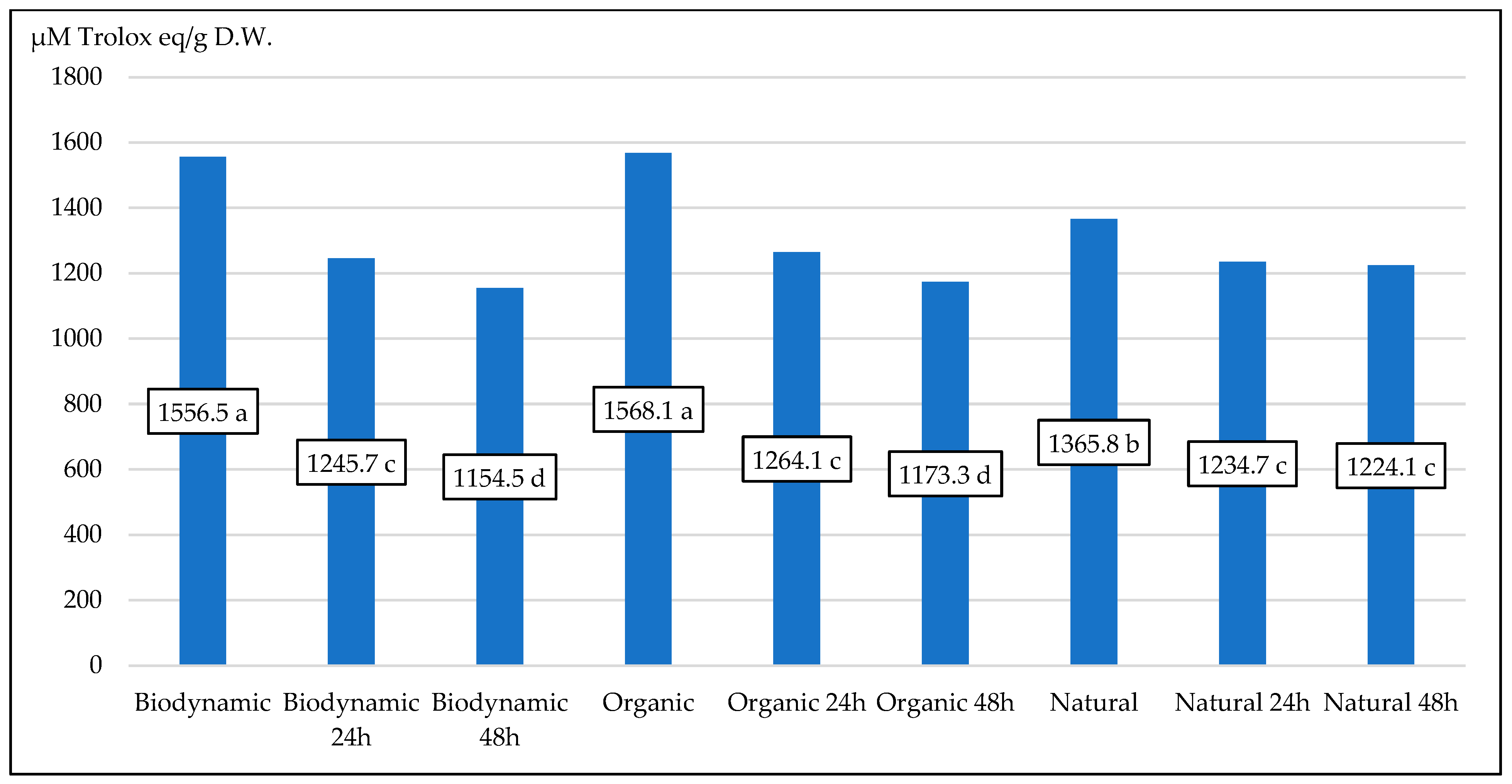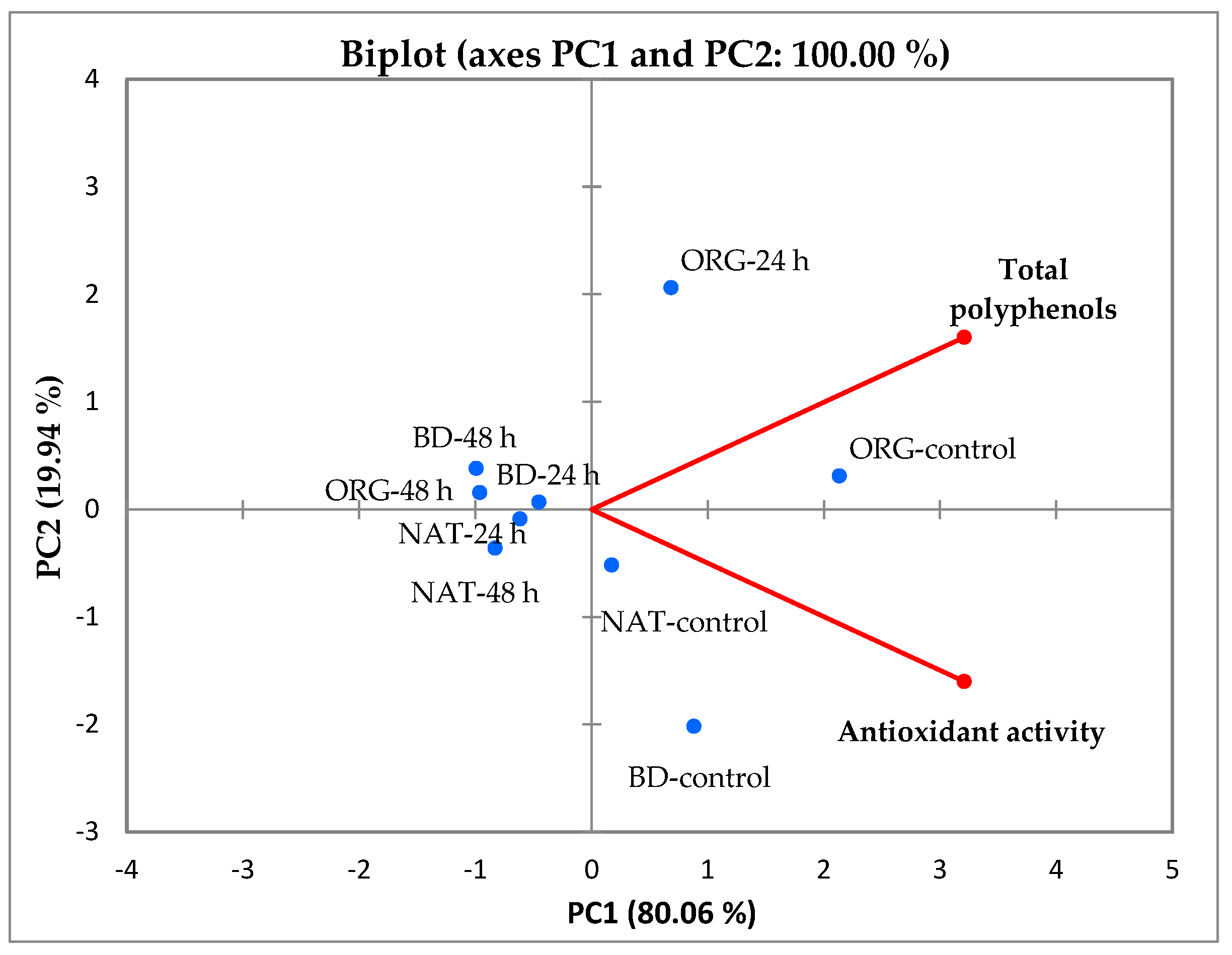Flavonoids, Phenolic Acids, and Tannin Quantities and Their Antioxidant Activity in Fermented Fireweed Leaves Grown in Different Systems
Abstract
:1. Introduction
2. Results
2.1. The Amounts of Biologically Active Compounds
2.2. The Antioxidant Activity of Biologically Active Compounds
2.3. The Principal Component Analysis
3. Discussion
4. Materials and Methods
4.1. Chemicals and Reagents
4.2. Field Experiment
4.2.1. Plants Material
4.2.2. Experimental Design
- -
- Naturally produced (control): 3.6 kg for a 24 h solid-phase fermentation, 1.2 kg for a 48 h fermentation, and 3.6 kg for no fermentation.
- -
- Fireweed cultivated organically: 3.6 kg (unfermented) for control, 3.6 kg for a 24 h solid-phase fermentation, and 3.6 kg for a 48 h fermentation.
- -
- Fireweed cultivated biodynamically: 3.6 kg (unfermented) for control, 3.6 kg for a 24 h solid-phase fermentation, and 3.6 kg for a 48 h fermentation.
- -
- Control (0 h): the leaves were kept for the anticipated amount of time but had not been fermented.
4.3. Laboratory Analyses
4.3.1. Polyphenol Identification and Quantification
4.3.2. Antioxidant Activity
4.4. Statistical Analysis
5. Conclusions
Supplementary Materials
Author Contributions
Funding
Data Availability Statement
Conflicts of Interest
References
- Reganold, J.P.; Papendick, R.; Parr, J.F. Sustainable agriculture. Sci. Am. 1990, 262, 112–120. [Google Scholar] [CrossRef]
- Carpenter-Boggs, L.; Kennedy, A.C.; Reganold, J.P. Organic, and biodynamic management: Effects on soil biology. Soil Sci. Soc. Am. J. 2000, 64, 1651–1659. [Google Scholar] [CrossRef]
- Marschner, P.; Crowley, D.; Yang, C.H. Development of specific rhizosphere bacterial communities in relation to plant species, nutrition, and soil type. Plant Soil 2004, 261, 199–208. [Google Scholar] [CrossRef]
- Girvan, M.S.; Pretty, J.N.; Osborn, A.M.; Ball, A.S. Soil type is the primary determinant of the composition of the total and active bacterial communities in arable soils. Appl. Environ. Microbiol. 2003, 69, 1800–1809. [Google Scholar] [CrossRef] [PubMed]
- Lasinskas, M.; Jariene, E. Applications of the narrow-leaved fireweed (Chamerion angustifolium L.): A review of research. Agric. Sci. 2018, 25, 125–130. [Google Scholar]
- Dzhafar, S.S.; Dalar, A.; Mükemre, M.; Ekin, S.; Yildiz, D.; Yunusoglu, O. Phytochemical profile and in vitro and in vivo anticonvulsant and antioxidant activities of Epilobium hirsutum. Int. J. Second. Metab. 2020, 7, 63–76. [Google Scholar] [CrossRef]
- Kaskoniene, V.; Maruska, A.; Akuneca, I.; Stankevicius, M.; Ragazinskiene, O.; Bartkuviene, V. Screening of antioxidant activity and volatile compounds composition of Chamerion angustifolium (L.) Holub ecotypes were grown in Lithuania. Nat. Prod. Res. 2016, 30, 1373–1381. [Google Scholar] [CrossRef] [PubMed]
- Maruska, A.; Ragazinskiene, O.; Vysniauskas, O.; Kaskoniene, V.; Bartkuviene, V.; Kornysova, O.; Briedis, V.; Ramanauskiene, K. Flavonoids of willowherb (Chamerion angustifolium (L.) Holub) and their radical scavenging activity during vegetation. Adv. Med. Sci. 2014, 59, 136–141. [Google Scholar] [CrossRef] [PubMed]
- Lasinskas, M.; Jariene, E.; Vaitkeviciene, N.; Kulaitiene, J.; Najman, K.; Hallmann, E. Studies of the variability of polyphenols and carotenoids in different methods fermented organic leaves of willowherb (Chamerion angustifolium (L.) Holub). Appl. Sci. 2020, 10, 5254. [Google Scholar] [CrossRef]
- Ponzio, C.; Gangatharan, R.; Neri, D. Organic and biodynamic agriculture: A review in relation to sustainability. Int. J. Plant Soil Sci. 2013, 2, 95–110. [Google Scholar] [CrossRef]
- Veberic, R. The impact of production technology on plant phenolics. Horticulturae 2016, 2, 8. [Google Scholar] [CrossRef]
- Akula, R.; Ravishankar, G.A. Influence of abiotic stress signals on secondary metabolites in plants. Plant Signal. Behav. 2011, 6, 1720–1731. [Google Scholar] [CrossRef]
- Vaitkeviciene, N.; Kulaitiene, J.; Jariene, E.; Levickiene, D.; Danilcenko, H.; Średnicka-Tober, D.; Rembiałkowska, E.; Hallmann, E. Characterization of Bioactive Compounds in Colored Potato (Solanum Tuberosum L.) Cultivars Grown with Conventional, Organic, and Biodynamic Methods. Sustainability 2020, 12, 2701. [Google Scholar] [CrossRef]
- Rockholm, D.C.; Yamamoto, H.Y. Violaxanthin De-Epoxidase. Purification of a 43-kilodalton lumenal protein from lettuce by lipid-affinity precipitation with monogalactosyldiacylglyceride. J. Plant Physiol. 1996, 110, 697–703. [Google Scholar] [CrossRef] [PubMed]
- Farnworth, E.R. The Evidence to support health claims for probiotics. J. Nutr. 2008, 138, 1250–1254. [Google Scholar] [CrossRef] [PubMed]
- Lasinskas, M.; Jariene, E. The content of phenolic acids in the different duration fermented leaves of fireweed (Chamerion angustifolium (L.) Holub. Agric. Sci. 2019, 26, 111–115. [Google Scholar] [CrossRef]
- Lasinskas, M.; Jariene, E.; Vaitkeviciene, N.; Hallmann, E.; Najman, K. Effect of Different Durations of Solid—Phase Fermentation for Fireweed (Chamerion angustifolium (L.) Holub) Leaves on the Content of Polyphenols and Antioxidant Activity In Vitro. Molecules 2020, 25, 1011. [Google Scholar] [CrossRef] [PubMed]
- Heimler, D.; Vignolini, P.; Arfaioli, P.; Isolani, L.; Romani, A. Conventional, organic and biodynamic farming: Differences in polyphenol content and antioxidant activity of Batavia lettuce. J. Sci. Food Agric. 2012, 92, 551–556. [Google Scholar] [CrossRef] [PubMed]
- Tassoni, A.; Tango, N.; Ferri, M. Polyphenol and biogenic amine profiles of Albana and Lambrusco grape berries and wines obtained following different agricultural and oenological practices. Food Nutr. Sci. 2014, 5, 8–16. [Google Scholar] [CrossRef]
- Demeter International. Handbuch—Einführung in Die Biodynamische Präpa-Ratearbeit; Demeter International: Darmstadt, Germany, 2013. [Google Scholar]
- Lasinskas, M.; Jariene, E.; Kulaitiene, J.; Vaitkeviciene, N.; Jakiene, E.; Skiba, D.; Hallmann, E. Studies of the Variability of Biologically Active Compounds and Antioxidant Activity in Organically, Biodynamically, and Naturally Grown and Fermented Fireweed (Chamerion angustifolium (L.) Holub) Leaves. Plants 2023, 12, 2345. [Google Scholar] [CrossRef]
- Re, R.; Pellegrini, N.; Proteggente, A.; Pannala, A.; Yang, M.; Rice-Evans, C. Antioxidant activity applying an improved ABTS radical cation decolorization assay. Free Radic. Biol. Med. 1999, 26, 1231–1237. [Google Scholar] [CrossRef] [PubMed]




| Mean Values | Sum of Identified Polyphenols, mg/100 g | Sum of Identified Phenolic Acids, mg/100 g | Sum of Identified Flavonoids, mg/100 g |
|---|---|---|---|
| biodynamic | 2465.88 ± 101.17 1 B 2 | 1665.14 ± 52.21 B | 800.74 ± 53.11 B |
| organic | 4042.35 ± 489.77 A | 3003.60 ± 428.77 A | 1038.75 ± 68.77 A |
| natural | 2321.69 ± 135.00 B | 1562.52 ± 139.39 B | 759.17 ± 14.87 B |
| Control | 3674.99 ± 399.50 a | 2684.37 ± 333.98 a | 990.62 ± 77.88 a |
| 24 h | 3165.61 ± 379.18 a | 2267.21 ± 345.23 a | 898.40 ± 35.84 b |
| 48 h | 1989.33 ± 36.52 b | 1279.68 ± 57.33 b | 709.65 ± 30.30 c |
| p-value | |||
| production system | <0.0001 | <0.0001 | <0.0001 |
| duration | <0.0001 | <0.0001 | <0.0001 |
| Production System | Duration, Hours | Sum of Identified Polyphenols, mg/100 g | Sum of Identified Phenolic Acids, mg/100 g | Sum of Identified Flavonoids, mg/100 g |
|---|---|---|---|---|
| biodynamic | Control | 2807.64 ± 50.81 1 b 2 | 1836.87 ± 50.86 bc | 970.77 ± 0.31 b |
| 24 h | 2498.73 ± 8.46 c | 1654.95 ± 8.46 c | 843.78 ± 0.08 c | |
| 48 h | 2091.28 ± 58.28 d | 1503.60± 58.28 c | 587.68 ± 1.16 e | |
| organic | Control | 5365.18 ± 70.17 a | 4089.38 ± 70.17 a | 1275.80 ± 57.66 a |
| 24 h | 4755.79 ± 136.34 a | 3714.36± 136.34 a | 1041.42 ± 32.99 b | |
| 48 h | 2006.10 ± 17.91 d | 1207.06 ± 17.91 e | 799.04 ± 15.53 d | |
| natural | Control | 2852.14 ± 14.79 b | 2126.85 ± 14.79 b | 725.30 ± 23.49 d |
| 24 h | 2242.32 ± 7.32 c | 1432.33 ± 7.32 d | 809.99± 7.23 bc | |
| 48 h | 1870.61 ± 5.67 e | 1128.38 ± 5.67 e | 742.22 ± 6.81 d | |
| p-Value | ||||
| production × duration | <0.0001 | <0.0001 | <0.0001 | |
| Mean Value | Gallic, mg/100 g | Chlorogenic, mg/100 g | P-Coumaric, mg/100 g | Ellagic, mg/100 g | Benzoic, mg/100 g |
|---|---|---|---|---|---|
| biodynamic | 21.36 ± 2.13 1 B 2 | 25.66 ± 1.35 B | 50.00 ± 1.93 B | 1549.34 ± 57.78 B | 18.78 ± 1.70 A |
| organic | 32.66 ± 1.13 A | 28.55 ± 0.71 B | 142.14 ± 3.93 A | 2788.41 ± 432.19 A | 11.84 ± 192 B |
| natural | 24.34 ± 1.58 B | 40.26 ± 1.87 A | 38.59 ± 2.61 C | 1453.88 ± 137.36 B | 5.46 ± 0.53 C |
| Control | 24.72 ± 3.18 b | 35.29 ± 2.53 a | 72.15 ± 13.48 b | 2540.80 ± 318.38 a | 11.41 ± 1.74 a |
| 24 h | 29.35 ± 1.25 a | 29.62 ± 3.03 b | 77.70 ± 15.11 b | 2121.15 ± 331.66 a | 9.39 ± 2.56 b |
| 48 h | 24.30 ± 1.58 b | 29.55 ± 1.07 b | 80.88 ± 18.12 a | 1129.68 ± 61.42 b | 15.28 ± 2.27 a |
| p-value | |||||
| production system | <0.0001 | <0.0001 | <0.0001 | <0.0001 | <0.0001 |
| duration | <0.0001 | <0.0001 | <0.0001 | <0.0001 | <0.0001 |
| Production System | Duration, Hours | Gallic, mg/100 g | Chlorogenic, mg/100 g | P-Coumaric, mg/100 g | Ellagic, mg/100 g | Benzoic, mg/100 g |
|---|---|---|---|---|---|---|
| biodynamic | Control | 12.55 ± 0.05 1 d 2 | 30.82 ± 0.09 b | 53.54 ± 1.00 c | 1728.01 ± 51.28 c | 11.95 ± 0.07 c |
| 24 h | 25.42 ± 1.36 b | 20.96 ± 0.07 e | 41.96 ± 0.32 d | 1546.37 ± 8.94 d | 20.24 ± 0.13 a | |
| 48 h | 26.12 ± 0.32 b | 25.19 ± 0.24 d | 54.50 ± 0.17 c | 1373.65 ± 57.98 e | 24.15 ± 0.21 a | |
| organic | Control | 35.36 ± 1.78 a | 29.07 ± 0.22 c | 128.24 ± 0.96 b | 3879.25 ± 11.65 a | 17.47 ± 0.56 b |
| 24 h | 33.75 ± 0.80 a | 25.77 ± 0.38 d | 141.64 ± 0.06 a | 3509.23 ± 130.05 a | 3.98 ± 0.04 f | |
| 48 h | 28.89 ± 0.17 ab | 30.80 ± 0.13 bc | 156.53 ± 2.14 a | 976.76 ± 13.70 f | 14.08 ± 0.26 bc | |
| natural | Control | 26.24 ± 0.25 b | 45.97 ± 0.26 a | 34.67 ± 0.03 e | 2015.15 ± 8.64 b | 4.82 ± 0.01 e |
| 24 h | 28.88 ± 0.02 ab | 42.14 ± 0.32 a | 49.50 ± 0.09 c | 1307.85 ± 12.03 e | 3.97 ± 0.24 f | |
| 48 h | 17.89 ± 0.70 c | 32.67 ± 0.26 b | 31.60 ± 0.59 e | 1038.63 ± 2.23 f | 7.59 ± 0.23 d | |
| p-value | ||||||
| production × duration | <0.0001 | <0.0001 | <0.0001 | <0.0001 | <0.0001 | |
| Mean Values | Oenothein B, mg/100 g | Quercetin-3-O-Rutinoside, mg/100 g | Myricetin, mg/100 g | Luteolin, mg/100 g | Quercetin, mg/100 g | Quercetin-3-O-Glucoside, mg/100 g | Kaempferol, mg/100 g |
|---|---|---|---|---|---|---|---|
| biodynamic | 727.27 ± 55.76 1 B 2 | 14.88 ± 0.30 B | 8.86 ± 0.50 B | 3.38 ± 0.24 A | 1.95 ± 0.07 C | 41.34 ± 2.27 B | 3.06 ± 0.06 C |
| organic | 869.57 ± 72.93 A | 58.90 ± 11.63 A | 15.96 ± 0.81 A | 2.55 ± 0.08 B | 2.28 ± 0.08 B | 84.39 ± 6.11 A | 5.10 ± 0.32 B |
| natural | 671.66 ± 14.08 C | 17.09 ± 0.54 B | 14.65 ± 0.78 A | 3.55 ± 0.10 A | 3.83 ± 0.10 A | 41.85 ± 1.43 B | 6.54 ± 0.26 A |
| Control | 899.26 ± 71.98 a | 24.91 ± 4.34 b | 13.05 ± 1.51 b | 3.02 ± 0.23 b | 2.41 ± 0.23 b | 42.84 ± 3.80 b | 5.13 ± 0.45 a |
| 24 h | 766.47 ± 17.03 b | 46.73 ± 14.28 a | 14.58 ± 1.21 a | 3.06 ± 0.09 b | 2.37 ± 0.09 b | 60.42 ± 8.38 a | 4.78 ± 0.60 a |
| 48 h | 602.76 ± 23.83 c | 19.23 ± 1.65 c | 11.85 ± 0.72 c | 3.41 ± 0.26 a | 3.27 ± 0.26 a | 64.33 ± 8.15 a | 4.79 ± 0.53 a |
| p-value | |||||||
| production system | <0.0001 | <0.0001 | <0.0001 | <0.0001 | <0.0001 | <0.0001 | <0.0001 |
| duration | <0.0001 | <0.0001 | <0.0001 | <0.0001 | <0.0001 | <0.0001 | n.s. |
| Production System | Duration, Hours | Oenothein B, mg/100 g | Quercetin-3-O- Rutinoside, mg/100 g | Myricetin, mg/100 g | Luteolin, mg/100 g | Quercetin, mg/100 g | Quercetin-3-O- Glucoside, mg/100 g | Kaempferol, mg/100 g |
|---|---|---|---|---|---|---|---|---|
| biodynamic | Control | 907.44 ± 0.35 1 a 2 | 15.68 ± 0.23 d | 6.97 ± 0.05 f | 2.76 ± 0.01 d | 1.86 ± 0.02 d | 32.75 ± 0.29 e | 3.30 ± 0.03 c |
| 24 h | 769.93 ± 0.58 b | 13.68 ± 0.8 e | 10.60 ± 0.13 de | 3.00 ± 0.02 c | 1.76 ± 0.02 e | 41.93 ± 0.38 d | 2.88 ± 0.02 d | |
| 48 h | 504.43 ± 0.97 d | 15.28 ± 0.06 d | 9.01 ± 0.17 e | 4.39 ± 0.01 a | 2.22 ± 0.01 c | 49.35 ± 0.20 c | 2.99 ± 0.02 d | |
| organic | Control | 1148.72 ± 56.82 a | 43.32 ± 0.46 ab | 14.34 ± 0.18 b | 2.34 ± 0.06 d | 2.03 ± 0.03 c | 58.61 ± 0.46 b | 6.44 ± 0.07 ab |
| 24 h | 809.96 ± 34.23 b | 107.21 ± 0.76 a | 19.37 ± 0.13 a | 2.81 ± 0.08 d | 1.88 ± 0.03 d | 95.86 ± 1.46 a | 4.33 ± 0.13 b | |
| 48 h | 650.02 ± 15.44 c | 26.17 ± 0.05 b | 14.18 ± 0.21 b | 2.49 ± 0.06 d | 2.94 ± 0.12 c | 98.70 ± 0.26 a | 4.55 ± 0.01 b | |
| natural | Control | 641.63 ± 22.59 c | 15.74 ± 0.07 d | 17.82 ± 0.16 ab | 3.94 ± 0.03 b | 3.35 ± 0.11 b | 37.16 ± 1.38 e | 5.65 ± 0.17 b |
| 24 h | 719.52 ± 8.26 b | 19.28 ± 0.21 c | 13.76 ± 0.17 c | 3.37 ± 0.07 bc | 3.47 ± 0.16 b | 43.45 ± 0.82 d | 7.13 ± 0.33 a | |
| 48 h | 653.83 ± 5.93 c | 16.23 ± 0.38 d | 12.37 ± 0.18 d | 3.35 ± 0.07 bc | 4.66 ± 0.17 a | 44.95 ± 2.09 d | 6.83 ± 0.23 ab | |
| p-value | ||||||||
| production × duration | <0.0001 | <0.0001 | <0.0001 | <0.0001 | 0.0092 | <0.0001 | <0.0001 | |
Disclaimer/Publisher’s Note: The statements, opinions and data contained in all publications are solely those of the individual author(s) and contributor(s) and not of MDPI and/or the editor(s). MDPI and/or the editor(s) disclaim responsibility for any injury to people or property resulting from any ideas, methods, instructions or products referred to in the content. |
© 2024 by the authors. Licensee MDPI, Basel, Switzerland. This article is an open access article distributed under the terms and conditions of the Creative Commons Attribution (CC BY) license (https://creativecommons.org/licenses/by/4.0/).
Share and Cite
Lasinskas, M.; Jariene, E.; Kulaitiene, J.; Vaitkeviciene, N.; Hallmann, E.; Paulauskas, V. Flavonoids, Phenolic Acids, and Tannin Quantities and Their Antioxidant Activity in Fermented Fireweed Leaves Grown in Different Systems. Plants 2024, 13, 1922. https://doi.org/10.3390/plants13141922
Lasinskas M, Jariene E, Kulaitiene J, Vaitkeviciene N, Hallmann E, Paulauskas V. Flavonoids, Phenolic Acids, and Tannin Quantities and Their Antioxidant Activity in Fermented Fireweed Leaves Grown in Different Systems. Plants. 2024; 13(14):1922. https://doi.org/10.3390/plants13141922
Chicago/Turabian StyleLasinskas, Marius, Elvyra Jariene, Jurgita Kulaitiene, Nijole Vaitkeviciene, Ewelina Hallmann, and Valdas Paulauskas. 2024. "Flavonoids, Phenolic Acids, and Tannin Quantities and Their Antioxidant Activity in Fermented Fireweed Leaves Grown in Different Systems" Plants 13, no. 14: 1922. https://doi.org/10.3390/plants13141922







